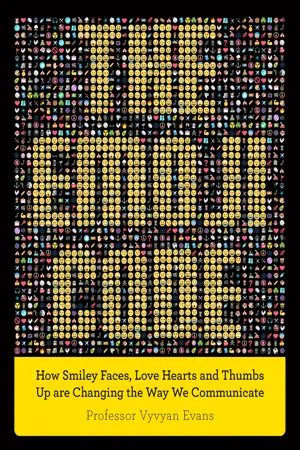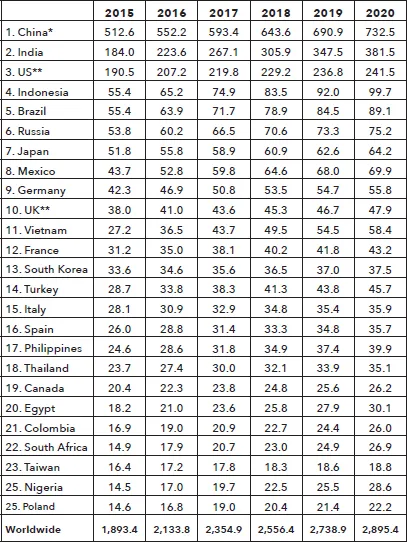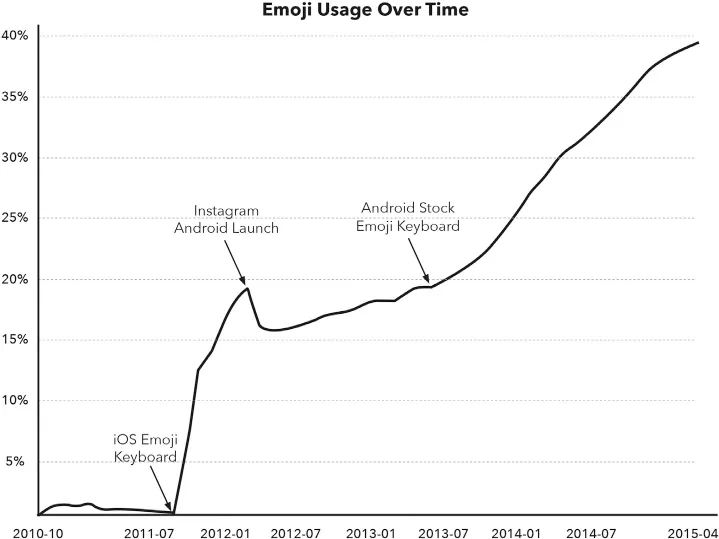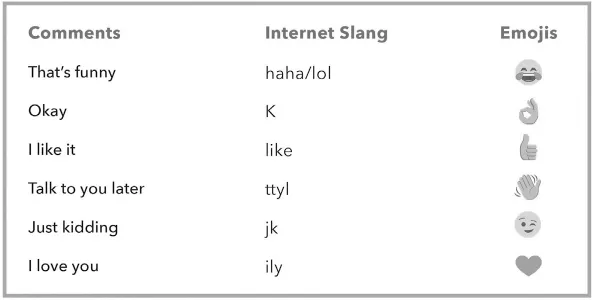![]()
CHAPTER 1
Is Emoji the New Universal ‘Language’?
Getting married is often regarded as one of life’s most significant events. It can distil our hopes and dreams, and reframe our everyday life; through its ritual and celebration and the serious business of taking vows, we commit to sharing our life with another. A wedding can also mark the passage from a more tranquil existence to the greater challenge of making and, for some, raising a family, and all the responsibilities and pressures that come with that. And, of course, most of us feel nervous ahead of the big day.
In April 2015, tennis star Andy Murray married his long-term girlfriend, Kim Sears. As is often the case with today’s celebrities, he sent a pre-wedding message to his bride, friends and followers. In the context of early twenty-first-century social media technology, this took the form of a tweet on the morning of his wedding day (see Figure 1 in the picture section). In the message Murray expressed his hopes and expectations for the day, as well as hinting at the nerves he no doubt felt. But what really got tongues wagging was the fact that his tweet was made up of nothing but emojis.1
Andy Murray’s tweet conveys, in pictorial form, the day’s events, as Murray expected them to unfold: the early morning preparations, the emotions, the journey to and from the church, the post-wedding partying, the consummation of the marriage and, finally, exhausted sleep. But, despite the headlines that it provoked at the time, Andy Murray’s Emoji tweet is not an isolated phenomenon. In February 2015, the Australian Minister for Foreign Affairs, Julie Bishop, an avid Emoji user, conducted the world’s first political interview entirely in Emoji – the interview was conducted via iMessage and published on the Buzzfeed website. In one question, Ms Bishop was asked to provide her emoji characterisations of various world leaders. Intriguingly, she identified the then Australian prime minister Tony Abbott as the running man, while Russian president Vladimir Putin was characterised as the angry red face.2
Even an institution as august as the BBC is not immune. Each Friday, the Newsbeat page on the BBC website – associated with BBC Radio 1 and aimed at younger listeners – publishes the news in Emoji. Radio listeners are invited to guess what the headline means. See whether you can figure out which headline the Emoji ‘sentence’ in Figure 2, in the picture section, relates to.3
Nor is the literary canon exempt: Ken Hale, a visual designer with a passion for Emoji, has translated, among other classics, Lewis Carroll’s Alice in Wonderland, a book of 27,500 or so words, into a pictorial narrative consisting of around 25,000 emojis.4 Some example Emoji ‘sentences’ provided by the artist are given in Figure 3.
Of course, it’s incredibly hard to read Emoji sentences. It’s for this very reason that the Newsbeat Emoji headline quiz is a competition. Part of the satisfaction of reading the ‘translations’ of the sentences, and the humour that we derive, comes from nodding your head in tacit understanding once you’ve read the words. The translations enable us to make sense of how the emojis might add up to a meaningful Emoji ‘sentence’. But just as with the emojified version of Alice in Wonderland, this all goes to show that Emoji just doesn’t function in the same way as a language. As we will see in more detail later in the book, Emoji lacks a grammar – a system of rules that lets us combine the individual glyphs into more complex units of meaning. And it is precisely for this reason that we require a helping-hand to make sense of the Newsbeat and Alice in Wonderland examples.
Emoji is becoming ubiquitous. The New York Public Radio station WNYC introduced a subway service, using emojis, to advise passengers of the status of particular New York City (NYC) subway lines. As the WNYC website explained, ‘We’re trying to estimate agony on the NYC subway by monitoring time between trains and adding unhappy points for stations typically crowded at rush hour.’5 You can find an example in Figure 5 in the picture section.
In response a leading online magazine has developed an emojified map of London’s underground rail system, affectionately known to Londoners as the Tube. Those familiar with London’s landmarks will instantly recognise stations such as Angel, Bank, Piccadilly Circus and so on (see Figure 6 in the picture section).
But is this all a gimmick, a passing fad? Could Emoji ever truly replace language in our digital communication? Or will it develop into a fully fledged language in its own right? And why is it that the younger generation are the most avid Emoji users? And beyond this, what about literacy and spelling standards – are they inevitable casualties of the rise of Emoji? In the final analysis, what does the uptake of Emoji mean for language, and for the future of human communication in the digital age? These are the very issues that I address in this book. And in the process, we’ll examine what language is, and isn’t, what role it plays in communication, and what the Emoji code reveals about these issues.
The rise and rise of Emoji
Emoji is an anglicised version of two Japanese words – e, ‘picture’, and moji, ‘character’. And for those who might not be crystal clear on the subject, emojis are the colourful symbols – the winks, smileys, love hearts and so on – embedded as single character images, or glyphs, in our digital keyboards. Since 2011, when they first became widely available on mobile computing devices, they have taken the world by storm. At the ingredients level, an emoji is a glyph encoded in fonts, like other characters, for use in electronic communication. It’s especially prevalent in digital messaging and social media. An emoji, or ‘picture character’, is a visual representation of a feeling, idea, entity, status or event. From a historical perspective, the first emojis were developed in the late 1990s in Japan for use in the world’s first mobile-phone internet system, then under development by Japanese telecommunications company NTT DoCoMo. There were originally 176 emoji characters. This figure mushroomed during the 2000s, driven by competition in the Japanese mobile computing sector. In 2009, the California-based Unicode Consortium, which specifies the international standard for the representation of text across modern digital computing and communication platforms, sanctioned a little over 700 emojis. These were based, primarily, on usage in Japanese mobile computing. The Unicode-approved emojis became available to software developers by 2010. At the time of writing, there are 1,851 emoji Unicode characters available to software developers, including skin-tone modifiers and various other combinations, sequences that produce couple and family emojis; but this figure will continue to rise6 – for the most up-to-date information, the ultimate source of Emoji facts, figures and cross-platform glyphs is emojipedia.org.7 But let’s be clear from the outset: Emoji is not a language in the way that, say, English, French or Japanese are languages; at least not yet. I’ll consider what makes something a language in Chapter 3, and how language-like Emoji is (and isn’t). And I’ll have a lot more to say on whether Emoji is likely to evolve into a language. That said, we need to be equally clear that Emoji represents a powerful system of communication; while not a language, it nevertheless fulfils some of the functions associated with language.
With that caveat in mind, the following fact is especially discombobulating: Emoji is, today, incontrovertibly the world’s first truly universal form of communication. Given that English is often said to be the world’s global language, to make the point clear, a comparison with English is a highly instructive point of departure.
While English doesn’t have the same number of first-language users as other languages – both Mandarin (900 million) and Spanish (427 million) have more native speakers – it has both status and reach that puts it on a different plane to any other. English has 339 million native speakers, with a further 603 million speakers who use it as a second language. This means there are around 942 million more-or-less fluent speakers in the world. And with another 500-plus million users with some degree of fluency, that makes for more than 1.5 billion people alive today with proficiency in English. It’s the primary or official language in 101 countries, from Canada to Cameroon, and Malta to Malawi – far outstripping any other language.8 It has been transplanted a great distance from its point of origin – a small country on a small island – spreading far beyond English shores. This was first achieved by the expansion and might of the British Empire, which at its height was the largest empire in history and the world’s foremost economic power for well over a century. By 1913, around 412 million people, almost a quarter of the world’s population at the time, were directly governed from London;9 and following the Great War of 1914–18, the British Empire controlled territories amounting to 13,700,000 square miles, around a quarter of the world’s total landmass.10 Since the Second World War, with the United States superseding the United Kingdom as the world’s most economically powerful nation, the influence of English has continued apace.
One interesting source of evidence of English’s far-reaching, and at times curious, impact comes from pseudo-English – foreign words that sound somewhat strangely English but aren’t. The Dutch and Germans refer to a mobile (or cell) phone as a ‘handy’, and many are even convinced this is an English term for this device. In Japan, the term is ‘cellar phone’. More bizarrely, in France, a glamorous Parisienne might indulge in an ‘unbrushing’ – a hairstyling event in which one’s hair is, counter-intuitively, styled (rather than unbrushed). In Moscow, the pseudo-Anglicism ‘feyskontrol’ (from face control) refers to the act of refusing entry at high-end nightclubs to those who aren’t quite the type of beautiful people the nightclub desires. The list goes on. Today, the ubiquitous influence of English in a wide array of global communication contexts is staggering: from commerce to diplomacy, from aviation to academic publishing, English serves as the global lingua franca.
But here comes the undiplomatic put-down; in comparison, Emoji dwarfs even the reach of English.
There are several ways in which we can measure the stratospheric rise of Emoji. One is the rapid rate of smartphone adoption – a ‘smart’ phone being defined as a wireless phone with mobile internet capability, just to be crystal clear. Smartphones were among the earliest devices that deployed the electronic keyboards which featured emojis as standard. Today nearly one quarter of the global population owns a smartphone; based on a survey of mobile computing habits in forty-one countries, it is estimated that there are currently over 2 billion smartphones in the world, with the figure set to continue to rise.11 By 2016, 3.2 billion people (approaching half the world’s population) had regular internet access, and 75 per cent of internet users accessed the internet via smartphones.12
Looking at specific countries, China exceeded 500 million smartphones during 2014, and India achieved more than 200 million smartphone users by 2016; in the USA the same figure was achieved by 2017, by which point 65 per cent of the population of the United States owned a smartphone.13 In terms of smartphones alone, by 2015 some 41.5 billion text messages were being sent globally every day; and across social media applications, each day more than 6 billion emojis are exchanged – mind-boggling figures.14 The table below shows the smartphone rate of adoption for the twenty-five nations that are the most avid users.
Another measure for assessing the uptake of Emoji comes from its penetration in social media applications. Let’s consider Instagram, the popular photo and video sharing platform. Instagram, founded in 2010, has well over 300 million active monthly users and counting, sharing over 70 million photos and videos every day.16 In fact, by the end of 2014, one fifth of the world’s internet users aged between sixteen and sixty-four had an Instagram account.17 In the first month following the launch of the Emoji keyboard in iOS, the uptake of emojis in text and captions on Instagram photos jumped from zero to 10 per cent. This further accelerated with the incorporation of Emoji in Android platforms. And by March 2015, nearly half of all text on Instagram posts contained emojis. The graph below illustrates the trend.
Source: eMarketer, Sep 2016.15 Methodology: estimates are based on the analysis of survey and traffic data from research firms and regulatory agencies, historical trends, and country-specific demographic and socioeconomic factors. Note: individuals of any age who own at least one smartphone and use the smartphone(s) at least once per month; *excludes Hong Kong; **forecast from Aug 2016. Smartphones are any voice handset with an advanced operating system (e.g. Android, BlackBerry, iOS, Windows Phone, etc.) and features/capabilities that resemble a PC.
Smartphone adoption rates.15
Yet another line of evidence, pointing to the rise and rise of Emoji, comes from the demise of textual forms of internet slang. For example, abbreviations used in SMS messages and social media applications, such as ‘lol’ (laugh out loud), ‘lolz’ (laugh out loud – with sarcasm), ‘imao’ (in my arrogant opinion – used to confidently assert something), or ‘omg’ (oh my god – used to express negative shock or surprise) are increasingly being replaced by the corresponding emojis.
For instance, in text captions on Instagram, the smiley face has come to replace a range of internet abbreviations that have semantically related meanings. These include: lolol, lmao, lololol, lolz, lmfao, lmaoo, lolololol, lol, ahahah, ahahha, loll, ahaha, ahah, lmfaoo, ahha, lmaooo, lolll, lollll, ahahaha, ahhaha, lml, lmfaooo. Moreover, and unlike the slang terms, many of which are language-specific (as in they are different in English, German, Japanese etc.), Emoji is now a near-universal form of communication, across all language groups of Instagram users. The general pattern of internet slang being replaced by emojis is captured by the table below.
In the UK, research that I conducted demonstrates that around 80 per cent of adult smartphone users – defined as e...



